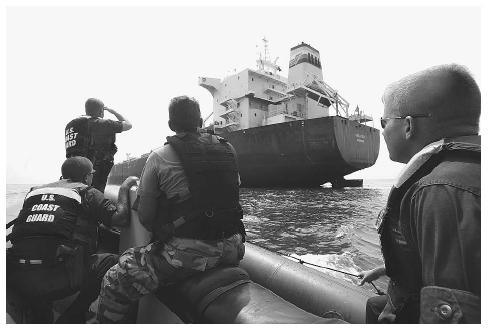Coast Guard (USCG), United States
█ CARYN E. NEUMANN
One of the world's leading maritime security forces, the United States Coast Guard (USCG), maintains public safety in American ports and shipping lanes while also enforcing laws against drug trafficking, environmental abuses, and illegal immigration. Created from a 1915 merger of the Life Saving Service and the Revenue Cutter Service, the Coast Guard is unique among the nation's armed services in that it has two masters. The Coast Guard has historically been attached to the U.S. Navy during times of war, but as of March 1, 2003, the Coast Guard acts under the direction of the Department of Homeland Security (transferred from the Department of Transportation). The USCG plays a major role in homeland security by screening passenger arrivals and conducting inspections at critical domestic ports as well as engaging in patrols of the American coastline.
The Coast Guard traces its origins to a 1790 act of Congress authorizing the construction of vessels to enforce tariff and trade laws, prevent smuggling, and protect the collection of the federal revenue. The Revenue Cutter Service that grew out of this order gradually assumed the additional duties of derelict destruction, protection of game, and enforcement of environmental laws. When the Revenue Cutter Service merged with the Life Saving Service, the newly formed USCG constituted a new branch of the military but a relatively poorly armed one. For most of its existence, the USCG has relied on light weapons that could be brought topside upon need while vessels operating inland generally had only small arms aboard. In war, USCG ships would add mounted guns, but such weaponry has not been deemed necessary for the routine peacetime activities of combating smuggling, assisting ships in distress, and conducting patrols.
The task assigned to the USCG is a daunting one. Over 95% of America's overseas trade moves by sea through 361 ports along 95,000 miles of coastline. It is more economical to bring in drugs and other illegal products in bulk by sea instead of by air, a fact that has prompted numerous traffickers to try their luck at evading the Coast Guard. To combat maritime smuggling, the service designed radar especially for marine traffic surveillance and control in 1972. At first, only operational in the key ports of San Francisco, Houston, Galveston, New Orleans, Puget Sound, and New York, radar is now commonly used, but the chief counter-smuggling activity of the Coast Guard remains the patrol of American waters by

ships and aircraft. In strategic ports, the USCG works closely with the U.S. Navy to protect naval assets. It has developed a methodology to conduct port vulnerability assessments to identify critical infrastructure and is in the process of establishing port security units to be rapidly deployed to provide law enforcement in the event of emergencies such as terrorist attacks.
About half of the USCG's resources are dedicated to public safety, a percentage that has increased in response to the attacks of September 11, 2001. In order to guard against future terrorist assaults, the Coast Guard screens crew and passenger lists obtained through the advance notice of vessel arrival forms that must be completed by all ships. It has developed a maritime homeland security strategy that involves coordinating USCG activities with the intelligence community, U.S. Customs Service, U.S. Navy, Border Patrol, and Immigration and Naturalization Service; sharing maritime intelligence with other nations; and conducting layered maritime security operations with the aim of deterring, disrupting, and intercepting threats before such dangers can reach American shores.
The survival of the Coast Guard seems assured. Congressional assertions that many of the duties of the USCG could be carried out more cheaply by private contractors have ceased as the threat of terrorism increases. Uniquely positioned to continue to provide the maritime component of homeland security, the USCG has decades of experience in detecting and intercepting unwanted intruders without significantly disrupting the transportation system.
█ FURTHER READING:
BOOKS:
Gottschalk, Jack A. and Brian P. Flanagan. Jolly Roger with an Uzi: The Rise and Threat of Modern Piracy. Annapolis: Naval Institute Press, 2000.
Johnson, Robert Erwin. Guardians of the Sea: History of the United States Coast Guard, 1915 to the Present. Annapolis: Naval Institute Press, 1987.
PERIODICALS:
Hessman, James D. "The Maritime Dimension; Special Report: The Coast Guard's Role in Homeland Defense." Sea Power (Apr 2002), pp. 26–30.
ELECTRONIC:
United States Department of Transportation. "United States Coast Guard." January 27, 2003. < http://www.uscg.mil/USCG.shtm.asp > (January 27, 2003).
SEE ALSO
Coast Guard National Response Center
Crime Prevention, Intelligence Agencies
Customs Service, United States
DEA (Drug Enforcement Administration)
INS (United States Immigration and Naturalization Service)
NMIC (National Maritime Intelligence Center)
September 11 Terrorist Attacks on the United States
Comment about this article, ask questions, or add new information about this topic: